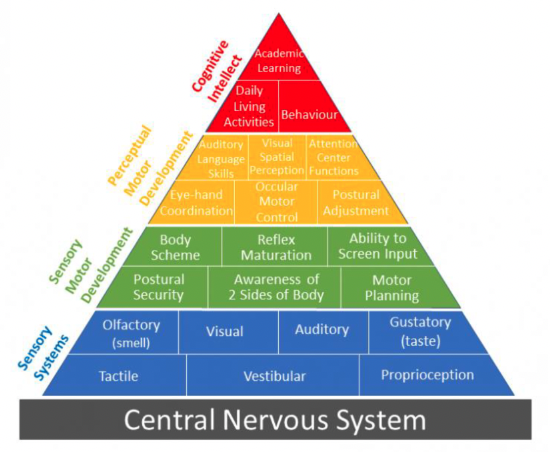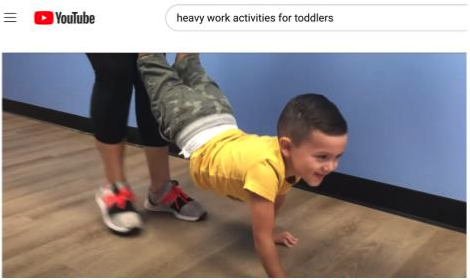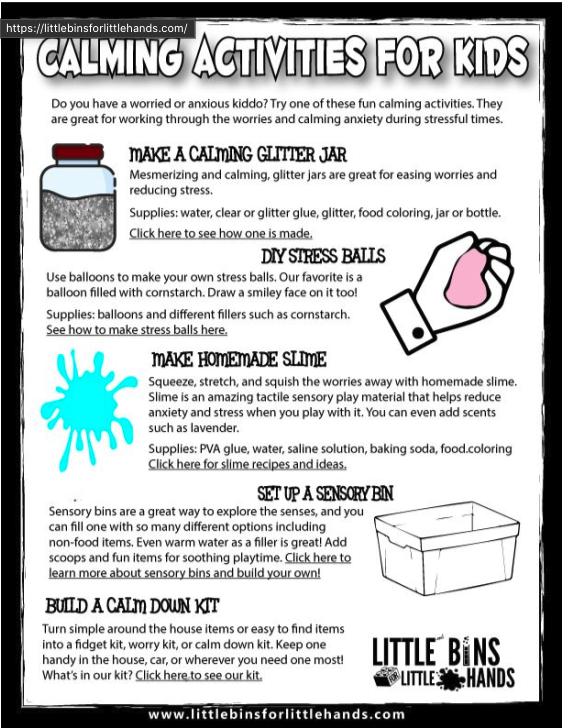Is your child’s sensory system dysregulated?
 What is sensory dysregulation? This is when the body is out of balance due to sensory experiences happening in the environment. This includes sight, hearing, taste, smell, touch, proprioception, interoception, and vestibular. All 8 senses are important to consider when trying to regulate a child’s sensory system. Sensory dysregulation can mean that there is too much or too little sensory stimulation in their environment. Not all children are the same, so sensory dysregulation can present differently depending on the child.
What is sensory dysregulation? This is when the body is out of balance due to sensory experiences happening in the environment. This includes sight, hearing, taste, smell, touch, proprioception, interoception, and vestibular. All 8 senses are important to consider when trying to regulate a child’s sensory system. Sensory dysregulation can mean that there is too much or too little sensory stimulation in their environment. Not all children are the same, so sensory dysregulation can present differently depending on the child.
Sight: Colors, patterns, shapes, movement, light
Smell: Foods, odors, nature, pleasant/unpleasant
Hearing: Loud, quiet, calm, repetitive, alarms, music
Taste: Spicy, sour, bitter, sweet, savory, crunchy, mushy, chewy
Touch: Other people, objects, tight, soft, rough, smooth
Proprioception: movement, position, balance
Vestibular: spatial orientation
Interoception: body temperature, sleepiness, pain, itching, hunger, thirst, sensation of urination and defecation
Terms to Know

Over-responsiveness may look like: sensory avoidant behaviors such as excessive covering of the ears, hiding, avoiding touch, or extreme picky eating. The body may be responding too much to the incoming information. One reaction is to avoid input to remain at baseline.
Under-responsiveness may look like: sensory seeking behaviors such as excessive or repetitive body movements, touching everything, making sounds, or licking/chewing on non-food items. The body may be responding too little to typical input, to the point that the seeker looks for more of it to remain at baseline.
Over-responsive -> Sensory Avoider -> Need for less sensory stimuli
Under-responsive -> Sensory Seeker -> Need for more sensory stimuli
Sensory Avoiding vs. Sensory Seeking Behaviors

Why is this important for kids to learn and grow?
Our sensory system is at the foundation of our pyramid of learning. Children will have difficulty climbing the pyramid to motor development and cognitive intellect if their basic needs are not met for their sensory systems.

Sensory Diet for Kids
Sensory seeker needing more: increase sensory stimuli
- Provide heavy work activities that get theirs muscles working such as help caregiver bring the groceries inside, build a fort, animal walks, and push/pull laundry basket.
- Try a children’s weighted blanket
- Listen to music and have a dance party or provide calm music stimuli during fine motor activities.
- Give tight hugs, squish in between pillows, and wrap up in a blanket burrito
- Provide crunchy snacks or chew tube
- Go to a park and swing, jump, run, go for a walk
- Dig in dirt or sand, let them get messy and explore their food, create sensory bin with uncooked rice and beans with hidden toys
Click here for more ‘heavy work’ activities!
 https://www.youtube.com/watch?v=oRJb12ZtWbg
https://www.youtube.com/watch?v=oRJb12ZtWbg
Sensory avoider needing less: reduce sensory stimuli
- Reduce any noise, provide quiet room to escape
- Remove any restrictive clothing, give them space from others
- Dim lighting, avoid florescent lights
- Teach them how to take deep breathes, drink some water or warm milk
Copy this link for more sensory activities!
https://childhood101.com/sensory-play-ideas/

Teach these strategies to children when they feel over or under whelmed so that they can learn to self-regulate. Help them identify by explaining why they are feeling the way they are and how they can fix it. Ask them if they need a break and allow them time to take breaks. Slowly introduce different textures into their play such as a sensory bin or playing with shaving cream to encourage exploratory play within their world.
 https://littlebinsforlittlehands.com
https://littlebinsforlittlehands.com
Copy this link for more sensory activities!
TIPS for Caregivers at home
- Observe your child to learn what they need to regulate their sensory systems. What makes them angry, frustrated, irritable, happy, or calm?
- Provide activities that encourage sensory stimulation at their pace.
- Provide a calm space for your child to escape to if they need a break.
- Go outside to get fresh air and explore the world.
- Be patient and educate your child about their feelings and body.
- Have your child evaluated by an occupational therapist for more support and education about your child’s specific needs.
- Give yourself grace when trying to learn the best ways to help your child’s sensory systems.
References
Beck, C. (2022, November 2). Understanding sensory dysregulation. The OT Toolbox. Retrieved November 23, 2022, from https://www.theottoolbox.com/understanding-sensory-dysregulation/
Burnett, C. (2021, September 3). 31 days of sensory play ideas: For Toddlers, preschool, kindy & more! Childhood101. Retrieved November 23, 2022, from https://childhood101.com/sensory-play-ideas/
Cubby Care. (2021). Sensory Play – The 5 Biggest Benefits. Cubby Care The Kindest Kind of Kindy. Retrieved November 23, 2022, from https://cubbycare.com.au/sensory-play-the-5-biggest-benefits/.
An Elite Cafemedia Family & Parenting. (2022, September 16). Simple science and stem for every day. Little Bins for Little Hands. Retrieved November 23, 2022, from https://littlebinsforlittlehands.com/
Mahler, K. J., & Craig, A. D. (2016). Interoception: the eighth sensory system: practical solutions for improving self-regulation, self-awareness and social understanding of individuals with autism spectrum and related disorders.
Morin, A. (2021, April 19). Sensory seeking vs. sensory avoiding in children. Understood. Retrieved November 23, 2022, from https://www.understood.org/en/articles/sensory-seeking-and-sensory-avoiding-what-you-need-to-know
T.E.AM. 4 Kids Pediatric Therapy . (2021). Therapy Tip of the Week – Heavy Work Activities to Regulate Children. YouTube. YouTube. Retrieved November 23, 2022, from https://www.youtube.com/watch?v=oRJb12ZtWbg.
Trott, M., & Taylor, K. (1991). Pyramid of Learning. Horizon Academy. Retrieved November 23, 2022, from https://horizon-academy.org/sensory-processing-disorder/.







